Established Model on Polycrystalline Graphene Oxide and Analysis of Mechanical Characteristic
Abstract
:1. Introduction
2. Model Establishment
3. Results and Discussion
3.1. Model Validation
3.2. The Effect of Strain Rate
3.3. The Effect of Temperature
3.4. The Effect of Oxygen-Containing Functional Group Position
4. Conclusions
Author Contributions
Funding
Institutional Review Board Statement
Informed Consent Statement
Data Availability Statement
Conflicts of Interest
References
- Novoselov, K.; Geim, A.; Morozov, S.; Jiang, D.; Zhang, Y.; Dubonos, S.; Grigorieva, I.; Firsov, A. Electric field effect in atomically thin carbon films. Science 2004, 306, 666–669. [Google Scholar] [CrossRef] [PubMed] [Green Version]
- Li, X.; Magnuson, C.; Venugopal, A.; An, J.; Suk, J.; Han, B.; Borysiak, M.; Cai, W.; Velamakanni, A.; Zhu, Y.; et al. Graphene films with large domain size by a two-step chemical vapor deposition process. Nano Lett. 2010, 10, 4328–4334. [Google Scholar] [CrossRef] [PubMed] [Green Version]
- Mondal, T.; Bhowmick, A.; Krishnamoorti, R. Controlled synthesis of nitrogen-doped graphene from a heteroatom polymer and its mechanism of formation. Chem. Mater. 2015, 27, 716–725. [Google Scholar] [CrossRef]
- Schniepp, H.; Li, J.; McAllister, M.; Sai, H.; Herrera-Alonso, M.; Adamson, D.; Prud’homme, R.; Car, R.; Saville, D.; Aksay, I. Functionalized single graphene sheets derived from splitting graphite oxide. J. Phys. Chem. B 2006, 110, 8535–8539. [Google Scholar] [CrossRef] [PubMed] [Green Version]
- Botas, C.; Álvarez, P.; Blanco, C.; Santamaría, R.; Granda, M.; Gutiérrez, M.; Rodríguez-Reinoso, F.; Menéndez, R. Critical temperatures in the synthesis of graphene-like materials by thermal exfoliation–reduction of graphite oxide. Carbon 2013, 52, 476–485. [Google Scholar] [CrossRef] [Green Version]
- Wan, H.; Zhang, Y. Interfacial bonding between graphene oxide and calcium silicate hydrate gel of ultra-high performance concrete. Mater. Struct. 2020, 53, 34. [Google Scholar] [CrossRef]
- Tavakol, M.; Montazeri, A.; Aboutalebi, S.H.; Asgari, R. Mechanical properties of graphene oxide: The impact of functional groups. Appl. Surf. Sci. 2020, 525, 146554. [Google Scholar] [CrossRef]
- Han, J.; Ryu, S.; Sohn, D.; Im, S. Mechanical strength characteristics of asymmetric tilt grain boundaries in graphene. Carbon 2014, 68, 250–257. [Google Scholar] [CrossRef]
- Hou, D.; Zhang, Q.; Wang, M.; Zhang, J.; Wang, P.; Ge, Y. Molecular dynamics study onwater and ions on the surface of graphene oxide sheet: Effects of functional groups. Comput. Mater. Sci. 2019, 167, 237–247. [Google Scholar] [CrossRef]
- Zheng, P.; Zhang, X.; Duan, Y.; Yan, M.; Chapman, R.; Jiang, Y.; Li, H. Oxidation of graphene with variable defects: Alternately symmetrical escape and self-restructuring of carbon rings. Nanoscale 2020, 12, 10140–10148. [Google Scholar] [CrossRef]
- Yang, Z.; Sun, Y.; Ma, F. Interlayer spacing of multilayer graphene oxide: Influences of oxygen-containing group density, thickness, temperature and strain. Appl. Surf. Sci. 2020, 529, 147075. [Google Scholar] [CrossRef]
- Jhon, Y.I.; Zhu, S.-E.; Ahn, J.-H.; Jhon, M.S. The mechanical responses of tilted and non-tilted grain boundaries in graphene. Carbon 2012, 50, 3708–3716. [Google Scholar] [CrossRef]
- Qin, X.; Yan, W.; Guo, X.; Gao, T. Effects of area, aspect ratio and orientation of rectangular nanohole on the tensile strength of defective graphene—A molecular dynamics study. RSC Adv. 2018, 8, 17034–17043. [Google Scholar] [CrossRef] [Green Version]
- Nardelli, M.B.; Fattebert, J.L.; Orlikowski, D.; Roland, C.; Zhao, Q.; Bernholc, J. Mechanical Properties, Defects and Electronic Behavior of Carbon Nanotubes. Carbon 2000, 38, 1703–1711. [Google Scholar] [CrossRef]
- Huang, P.Y.; Ruiz-Vargas, C.S.; van der Zande, A.M.; Whitney, W.S.; Levendorf, M.P.; Kevek, J.W.; Garg, S.; Alden, J.S.; Hustedt, C.J.; Zhu, Y.; et al. Grains and grain boundaries in single-layer graphene atomic patchwork quilts. Nature 2011, 469, 389–393. [Google Scholar] [CrossRef] [PubMed] [Green Version]
- Song, Z.; Artyukhov, V.I.; Yakobson, B.I.; Xu, Z. Pseudo Hall-Petch strength reduction in polycrystalline graphene. Nano Lett. 2013, 13, 1829–1833. [Google Scholar] [CrossRef] [PubMed]
- Grantab, R.; Shenoy, V.B.; Ruoff, R.S. Anomalous Strength Characteristics of Tilt Grain Boundaries in Graphene. Science 2010, 330, 946–948. [Google Scholar] [CrossRef] [PubMed] [Green Version]
- Liu, T.-H.; Pao, C.-W.; Chang, C.-C. Effects of dislocation densities and distributions on graphene grain boundary failure strengths from atomistic simulations. Carbon 2012, 50, 3465–3472. [Google Scholar] [CrossRef]
- Lee, G.-H.; Cooper, R.C.; An, S.J.; Lee, S.; van der Zande, A.; Petrone, N.; Hammerberg, A.G.; Lee, C.; Crawford, B.; Oliver, W.; et al. High-Strength Chemical-Vapor–Deposited Graphene and Grain Boundaries. Science 2013, 340, 1073–1076. [Google Scholar] [CrossRef]
- Rasool, H.I.; Ophus, C.; Klug, W.S.; Zettl, A.; Gimzewski, J. Measurement of the intrinsic strength of crystalline and polycrystalline graphene. Nat. Commun. 2013, 4, 385–388. [Google Scholar] [CrossRef]
- Szabó, T.; Berkesi, O.; Forgó, P.; Josepovits, K.; Sanakis, Y.; Petridis, D.; Dékány, I. Evolution of Surface Functional Groups in a Series of Progressively Oxidized Graphite Oxides. Chem. Mater. 2006, 18, 2740–2749. [Google Scholar] [CrossRef]
- Lotya, M.; Hernandez, Y.; King, P.; Smith, R.; Nicolosi, V.; Karlsson, L.; Blighe, F.; De, S.; Wang, Z.; McGovern, I.; et al. Liquid phase production of graphene by exfoliation of graphite in surfactant/water solutions. J. Am. Chem. Soc. 2009, 131, 3611–3620. [Google Scholar] [CrossRef] [PubMed] [Green Version]
- Zhang, Y.; Zhang, Q.; Hou, D.; Zhang, J. Tuning interfacial structure and mechanical properties of graphene oxide sheets/polymer nanocomposites by controlling functional groups of polymer. Appl. Surf. Sci. 2020, 504, 144152. [Google Scholar] [CrossRef]
- Chen, J.; Dai, F.; Zhang, L.; Xu, J.; Liu, W.; Zeng, S.; Xu, C.; Chen, L.; Dai, C. Molecular insights into the dispersion stability of graphene oxide in mixed solvents: Theoretical simulations and experimental verification. J. Colloid Interface Sci. 2020, 571, 109–117. [Google Scholar] [CrossRef] [PubMed]
- Hou, D.; Yang, T. A reactive molecular dynamics study of graphene oxide sheets in different saturated states: Structure, reactivity and mechanical properties. Phys. Chem. Chem. Phys. 2018, 20, 11053–11066. [Google Scholar] [CrossRef] [PubMed]
- Van Duin, A.C.T.; Dasgupta, S.; Lorant, F.; Goddard, W.A. ReaxFF: A Reactive Force Field for Hydrocarbons. J. Phys. Chem. A 2001, 105, 9396–9409. [Google Scholar] [CrossRef] [Green Version]
- Chenoweth, K.; Van Duin, A.C.; Goddard, W.A. ReaxFF reactive force field formolecular dynamics simulations of hydrocarbon oxidation. J. Phys. Chem. A 2008, 112, 1040–1053. [Google Scholar] [CrossRef] [Green Version]
- Pei, Q.-X.; Zhang, Y.-W.; Shenoy, V.B. A molecular dynamics study of the mechanical properties of hydrogen functionalized graphene. Carbon 2009, 48, 898–904. [Google Scholar] [CrossRef]
- Sadeghzadeh, S.; Rezapour, N. The mechanical design of graphene nanodiodes and nanotransistors: Geometry, temperature and strain effects. RSC Adv. 2016, 6, 86324–86333. [Google Scholar] [CrossRef]
- Yao, W.J.; Fan, L. Research on the correlation of mechanical properties of BN–graphene–BN/BN vertically-stacked nanostructures in the presence of interlayer sp3 bonds and nanopores with temperature. Phys. Chem. Chem. Phys. 2020, 22, 5920–5928. [Google Scholar] [CrossRef]
- Zhao, S.J.; Xue, J.M. Mechanical properties of hybrid graphene and hexagonal boron nitride sheets as revealed by molecular dynamic simulations. J. Phys. D Appl. Phys. 2013, 46, 135303. [Google Scholar] [CrossRef]
- Yi, L.; Yin, Z.; Zhang, Y.; Chang, T. A theoretical evaluation of the temperature and strain-rate dependent fracture strength of tilt grain boundaries in graphene. Carbon 2013, 51, 373–380. [Google Scholar] [CrossRef]
- Yang, Z.; Sun, Y. Tension dynamics of graphene oxide and peculiar change of yield strain. Appl. Nanosci. 2020, 10, 1825–1831. [Google Scholar] [CrossRef]
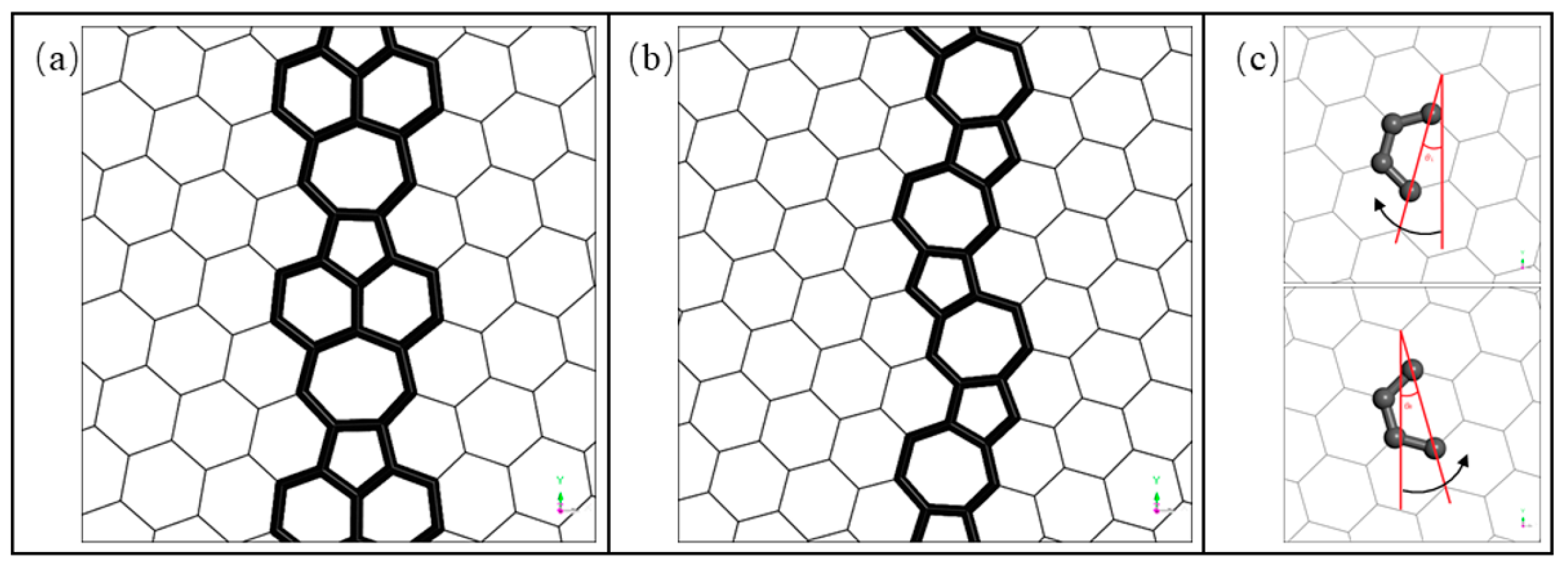
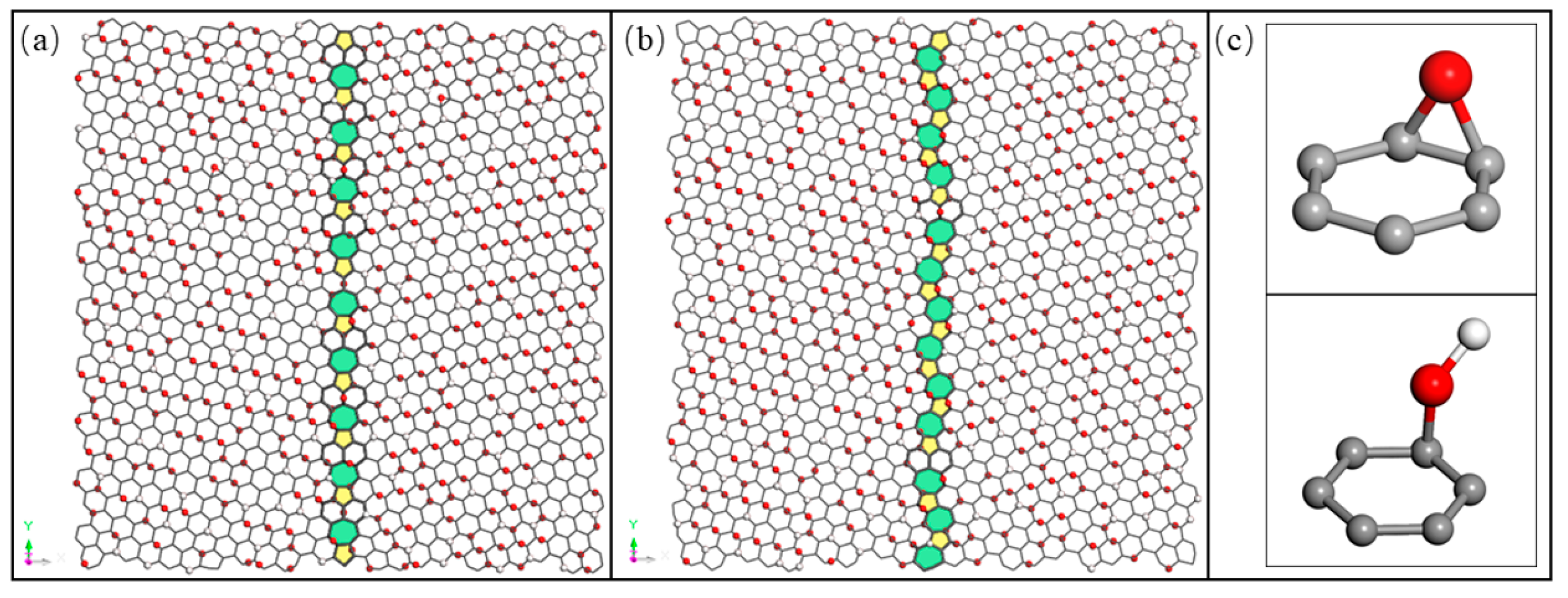


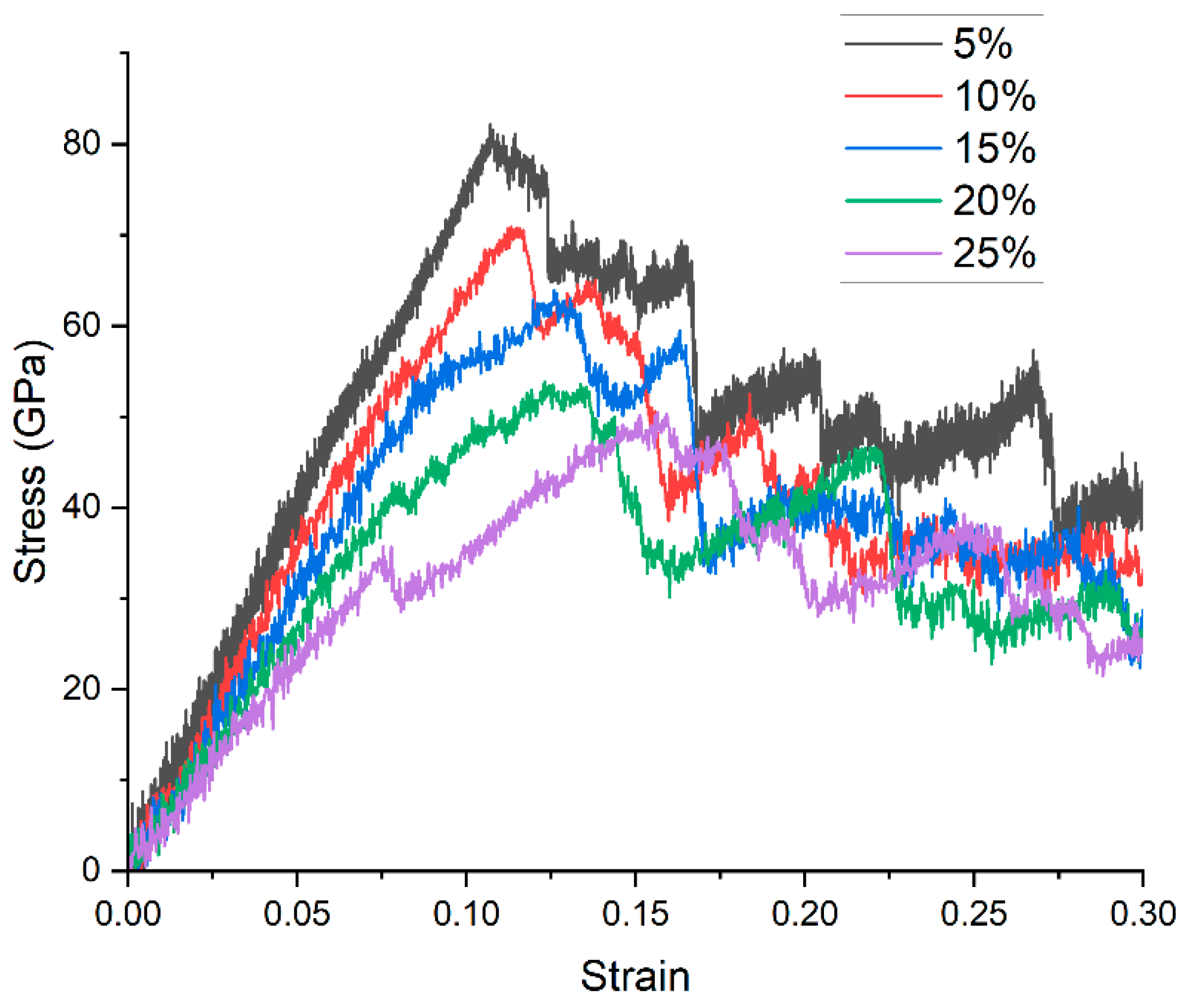

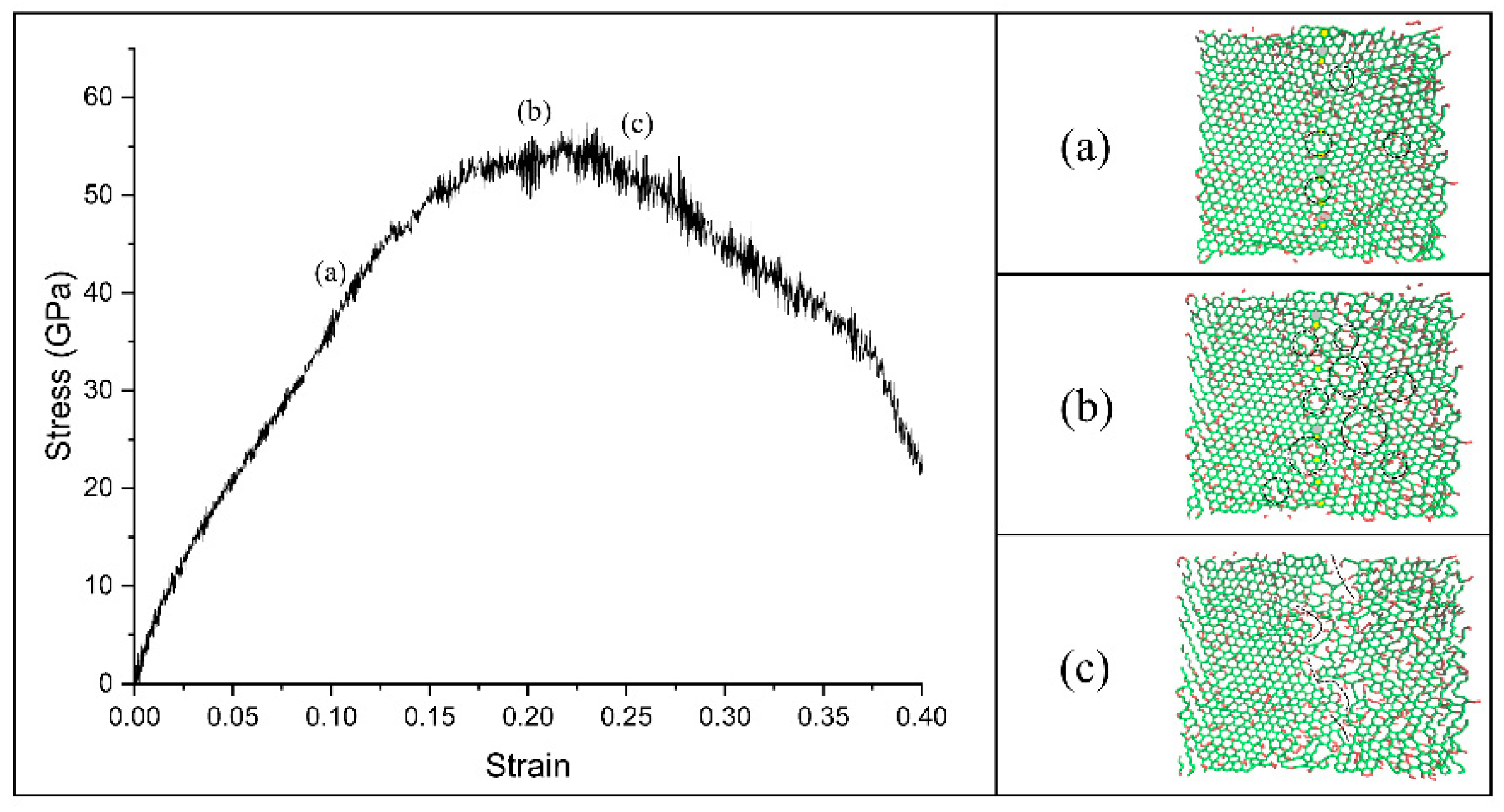
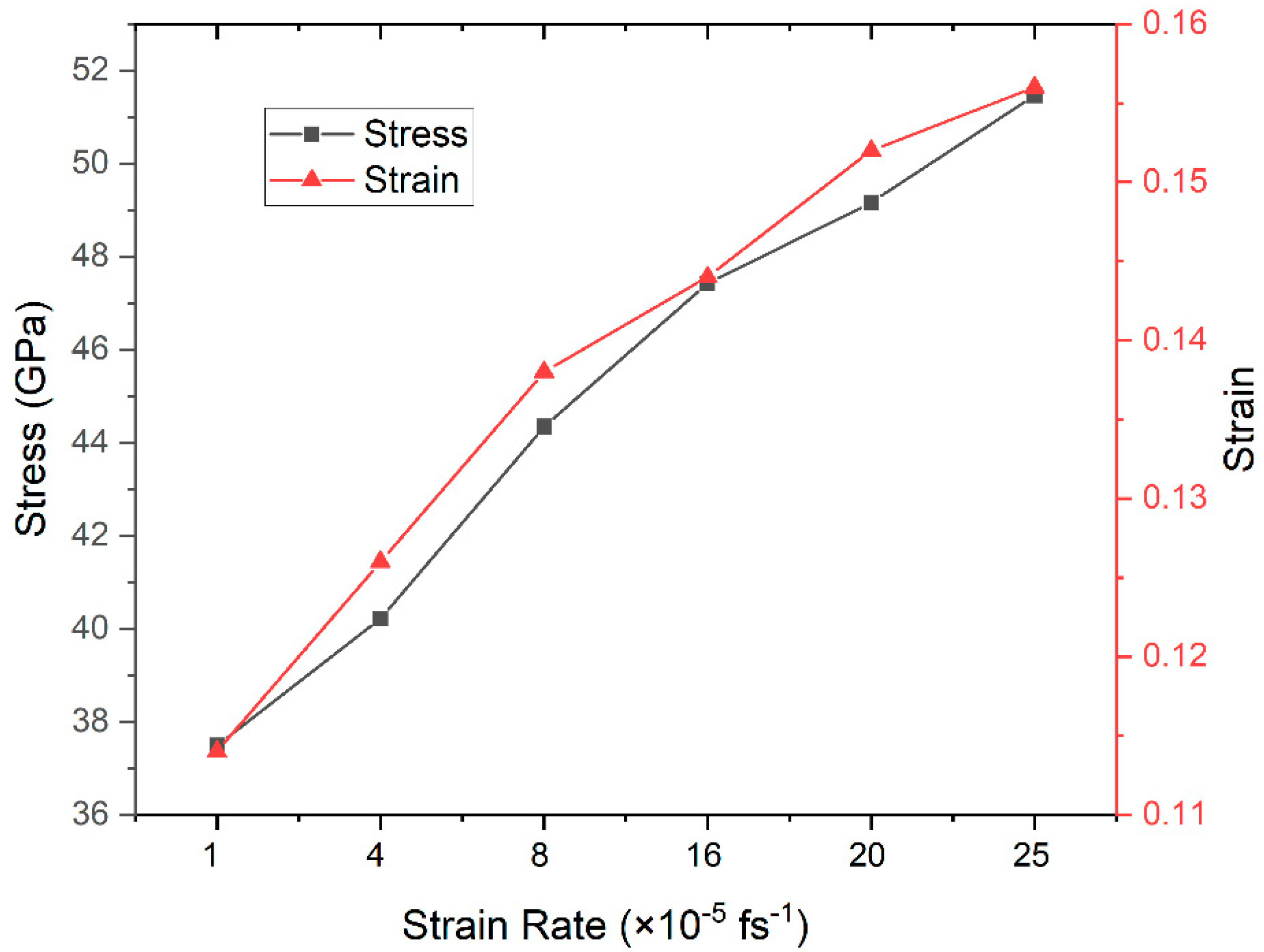
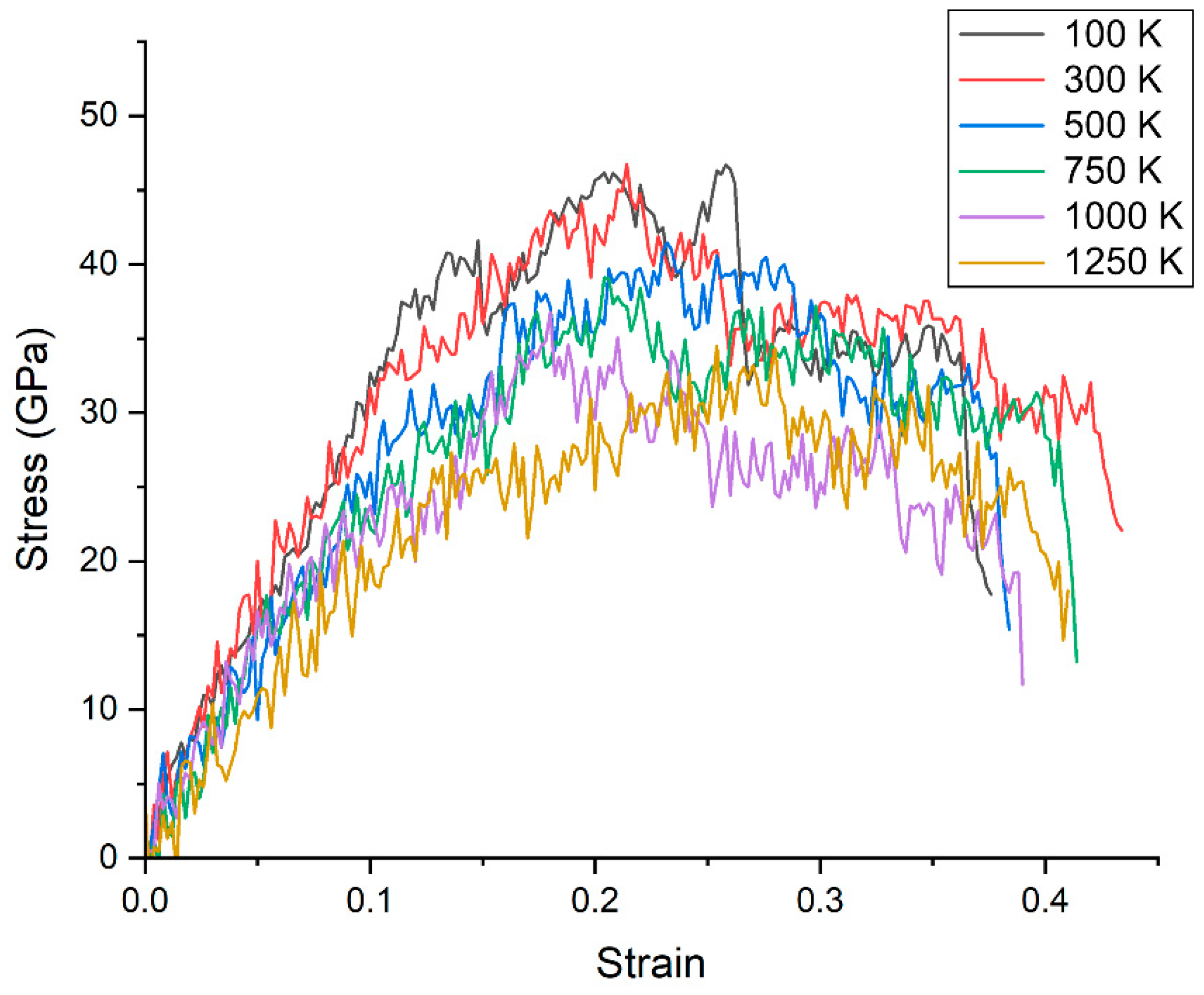
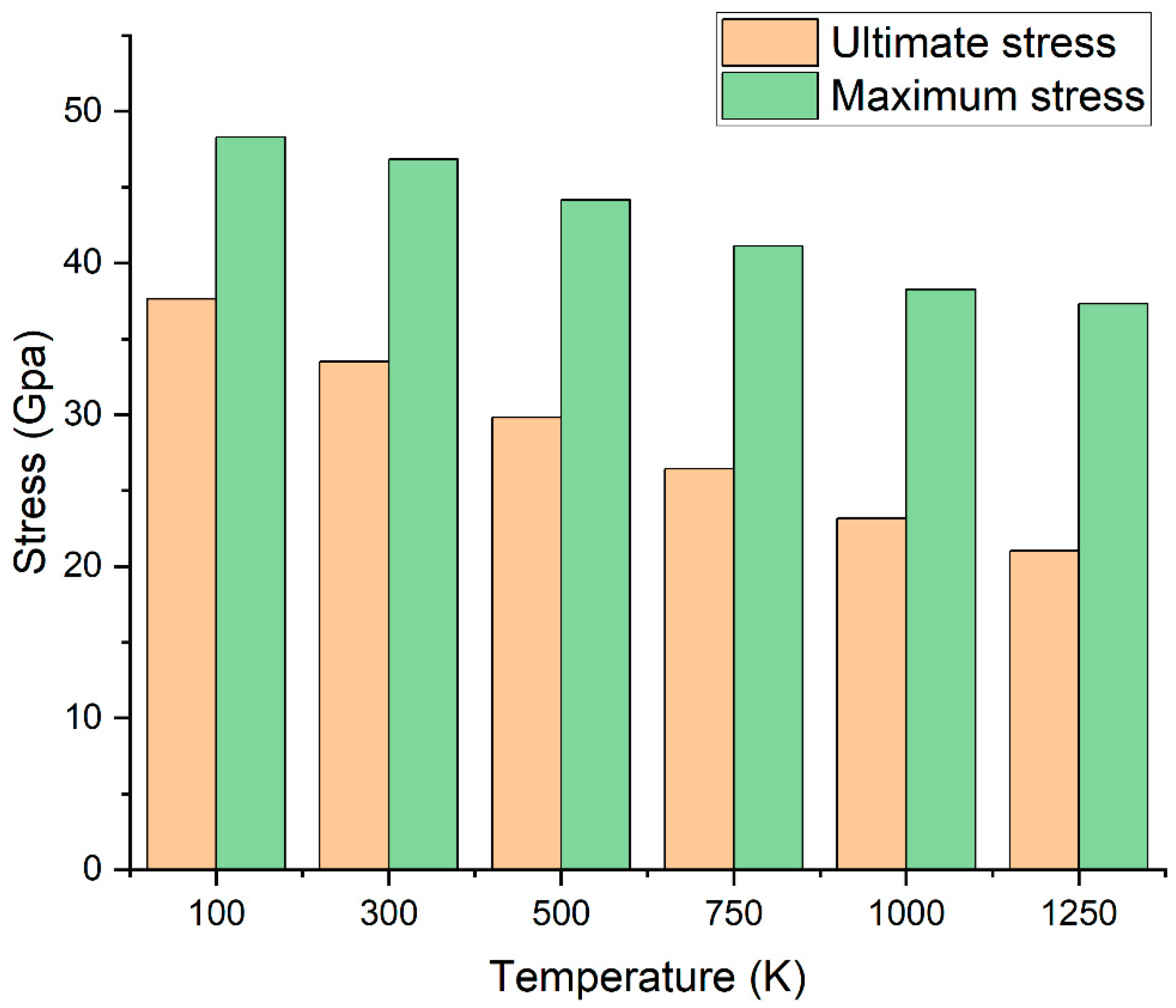

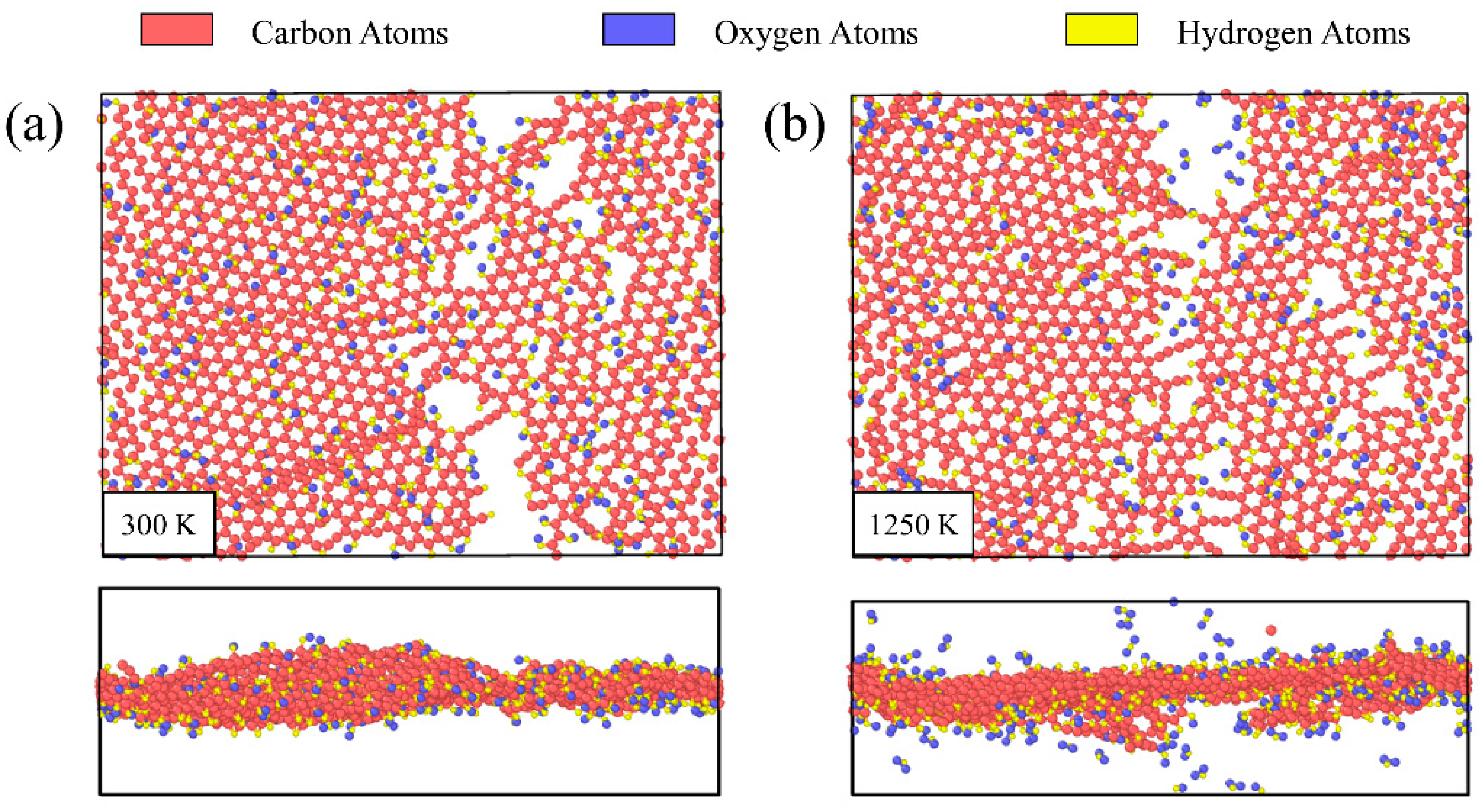


| Temperature (K) | Ultimate Stress (GPa) | Ultimate Strain | Maximum Stress (GPa) | Young’s Modulus (GPa) |
|---|---|---|---|---|
| 100 | 37.64 | 0.120 | 48.31 | 313.67 |
| 300 | 33.51 | 0.118 | 46.83 | 283.98 |
| 500 | 29.84 | 0.120 | 44.17 | 248.67 |
| 750 | 26.44 | 0.120 | 41.12 | 220.33 |
| 1000 | 23.18 | 0.105 | 38.25 | 220.76 |
| 1250 | 21.02 | 0.110 | 37.33 | 191.09 |
| Numbers of Local Carbon Atoms | Misorientation Angle (°) | Oxygen Content | Numbers of Epoxy Group | Numbers of Hydroxyl | |
|---|---|---|---|---|---|
| PGO-1 | 133 | 21.8 | 49.6% | 22 | 22 |
| PGO-2 | 154 | 21.8 | 49.4% | 25 | 26 |
| PGO-3 | 154 | 21.8 | 49.4% | 25 | 26 |
| PGO-4 | 118 | 30 | 50.8% | 20 | 20 |
| PGO-5 | 153 | 30 | 49.7% | 25 | 26 |
| PGO-6 | 153 | 30 | 49.7% | 25 | 26 |
| Model | Temperature (K) | Ultimate Stress (GPa) | Ultimate Strain | |
|---|---|---|---|---|
| 1 | PGO-1 | 300 | 48.701 | 0.1128 |
| 2 | PGO-2 | 300 | 46.520 | 0.1094 |
| 3 | PGO-3 | 300 | 59.488 | 0.1686 |
| 4 | PGO-1 | 500 | 46.584 | 0.1052 |
| 5 | PGO-2 | 500 | 45.146 | 0.1084 |
| 6 | PGO-3 | 500 | 55.259 | 0.1480 |
| 7 | PGO-4 | 300 | 53.785 | 0.1146 |
| 8 | PGO-5 | 300 | 49.054 | 0.1026 |
| 9 | PGO-6 | 300 | 65.271 | 0.1258 |
| 10 | PGO-4 | 500 | 49.440 | 0.0854 |
| 11 | PGO-5 | 500 | 46.429 | 0.1052 |
| 12 | PGO-6 | 500 | 66.886 | 0.1158 |
Publisher’s Note: MDPI stays neutral with regard to jurisdictional claims in published maps and institutional affiliations. |
© 2022 by the authors. Licensee MDPI, Basel, Switzerland. This article is an open access article distributed under the terms and conditions of the Creative Commons Attribution (CC BY) license (https://creativecommons.org/licenses/by/4.0/).
Share and Cite
Xu, X.; Xiong, C.; Mao, S.; Yao, W. Established Model on Polycrystalline Graphene Oxide and Analysis of Mechanical Characteristic. Crystals 2022, 12, 382. https://doi.org/10.3390/cryst12030382
Xu X, Xiong C, Mao S, Yao W. Established Model on Polycrystalline Graphene Oxide and Analysis of Mechanical Characteristic. Crystals. 2022; 12(3):382. https://doi.org/10.3390/cryst12030382
Chicago/Turabian StyleXu, Xu, Chaoqi Xiong, Shaoping Mao, and Wenjuan Yao. 2022. "Established Model on Polycrystalline Graphene Oxide and Analysis of Mechanical Characteristic" Crystals 12, no. 3: 382. https://doi.org/10.3390/cryst12030382





